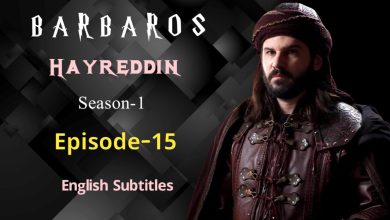Barbaloslar
Barbaros: Sword of the Mediterranean Episode 3
Beautiful indeed as such a ship was, there was another side to her: something that explained the perfumes and unguents worn by the gentry on the poop, or held to their noses in delicately pierced pomanders. “It is not necessary to look far to find an extreme contrast with the pride of the galley’s appearance.
At the very moment that the galley dazzles one’s eyes with her sculptures, her draperies and her movement through the water, she horribly affronts one’s nostrils, and exudes throughout her whole length the utmost misery …” Now, as the papal galley altered course slightly to pass through the five-mile-wide channel between the island of Elba and the mainland of Italy, a watcher standing on the rocky cliffs of Piombino might have
thought her beautiful indeed. The very way in which, between each stroke, the blades of her oars were momentarily suspended above the water, like the wings of a hovering falcon, would have entranced the eye. Then, as they dipped again in one easy flowing motion, she glided swiftly forward. But it was the motive power for these oars, the wretched toiling men who, in their semidarkness and stench, made the galley repulsive to the nostrils. Hygiene was little comprehended in the sixteenth century, and a galley’s bilges—even though regularly pumped out—were foul from men who were compelled to urinate and defecate at the very benches where they laboured in their chains.
Below decks in the long waist of the ship, seated four, five, or six at the heavy looms of the oars, the galley’s “machinery” was at work. “They are chained six to a bench,” one who was himself a galley slave tells us. “The benches are four feet wide covered with sacking stuffed with wool over which are thrown sheepskins which reach to the deck beneath them. The officer who is master of the galley slaves remains aft with the captain to receive his orders. There are two under officers, one amidships and one at the prow; and all of them are armed with whips, with
which they flog the totally naked bodies of the slaves. When the captain gives the order to row, the officer gives the signal with a silver whistle which hangs on a cord around his neck. The signal is repeated by the under officers and very soon all the fifty oars strike the water as if one. Imagine six men chained to a bench as naked as they were bom, one foot on the stretcher, the other raised and placed on the bench in front of them, holding in their hands an oar of immense weight, stretching their bodies towards the after part of the galley with arms
extended to push the loom of the oar clear of the backs of those in front of them, who are in the same attitude. They plunge the blades of the oars into the water and throw themselves back, falling onto the seat which bends beneath their weight. Sometimes the galley slaves row thus ten, twelve, even twenty hours at a stretch, without the slightest respite or rest. On these occasions the officer will go round, putting into the mouths of the wretched rowers pieces of bread soaked in wine to prevent them from fainting …” Small wonder then that Grossino, a North Italian visitor to Rome, viewing some Turkish galley slaves, could remark: “Poor creatures! They must envy
the dead.” Most of these men who drove the beautiful papal galley on her way down the coast were Moslems—either captured Turks, Arabs, or Moors from the North African coast. The complement of the oar benches was also reinforced by condemned criminals, and by a third class of galley slave, the “volunteers.” The latter were men who had fallen into debt and who, to escape the harsh punishment inflicted on debtors, had preferred to serve at the oar. Their small wages were then paid directly to their creditors until such time as their debts were
discharged. But increasingly throughout the sixteenth century, as the conflict between East and West in the Mediterranean reached new heights, it was the captured and enslaved enemy who formed the bulk of the crew below decks.
Viewed by a lookout above Piombino, the galley, as she neared the narrow strait, would have resembled some colourful water insect. Her great oars, the remi di scallocio, seemed to walk the hull on legs across the still blue water.
But this galley, in any case, had long been under observation.
The island of Elba lies like a fish off Piombino, with its head pointed towards Corsica and its forked tail towards the mainland. It was important for its iron ore and for its skilled metalworkers, and there was a regular trade
between Elba and the ports supplying Rome and the other inland cities of Italy. It was this, perhaps, which had lured up into a sea hitherto “safe for Christians” the lean Turkish galleot that now idled under the shadow of the great rocks, hidden in a cove below the northern fin of the island. On the other hand, it was just as likely the knowledge that the coastal route between Elba and Piombino was much followed by rich merchant ships bound for Rome which had brought so far north the sea captain Aruj and his Turkish crew.
In marked contrast to the large papal galley now entering the channel, the Moslem galley (technically a galleot because of her size) had no more than eighteen banks of oars on either side, as compared with the twenty-seven of the Christian vessel. She was a great deal shorter on the waterline as well as in beam, while her lighter oars were worked by only two or three men. In this case, however, there was a further and important difference— the
Even so, as the Turks who had been watching the approach of the galley from a vantage point above the headland ran down to acquaint their captain, Aruj, there was
some doubt and hesitation among the crew. Aruj himself had none, set the men to the oars, and made out into the channel to meet the papal galley head on. “The Turks, weighing the bulk of the galley against the feebleness of their galleot, utterly condemned the madness of the proposal, and plainly told their captain that he reflected not; that the second galley might, easily enough for their destruction, come up to its consort’s assistance; adding
that, instead of offering to be so rash as to attack an enemy so far above their match, and who had succour of equal force within sight, they thought it their business to make off with speed, in order to escape such evident danger. “ ‘God forbid,’ replied the determined Corsair, ‘that I should ever live to be branded with such infamy!’ ” On she came, dip, sweep, pause, and dip again—the great, heavy, beautiful bird, carving her way through the sea. Meanwhile the small, but agile and bright-eyed, hawk awaited her. There was indeed, in the conflict about to take place, something reminiscent of the loosing of a hunting hawk upon a bustard in the desert. “If the attack is successful, the spectator sees a white flutter of feather and tail, a scuffle on the ground, possibly several swoops
on the part of the hawk, then all is quiet as the hawk seizes his quarry by the neck. White feathers soon fly in the breeze as the hawk plucks the breast of his prey preparatory to having a bite of its flesh . .
Aruj, the rais, or captain, of the galleot, was not the man to listen to his crew’s fears. Whatever his faults, he was, above all, that unusual human being, a total “man of action.” He was, perhaps, to fail in his life through not listening often enough to the cool voice of reason, yet all his successes were to derive from his ability to “grasp the nettle, danger.”

